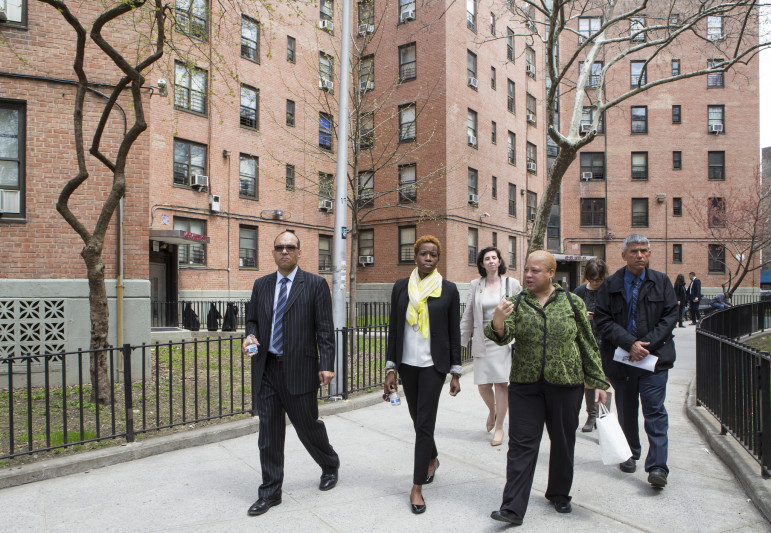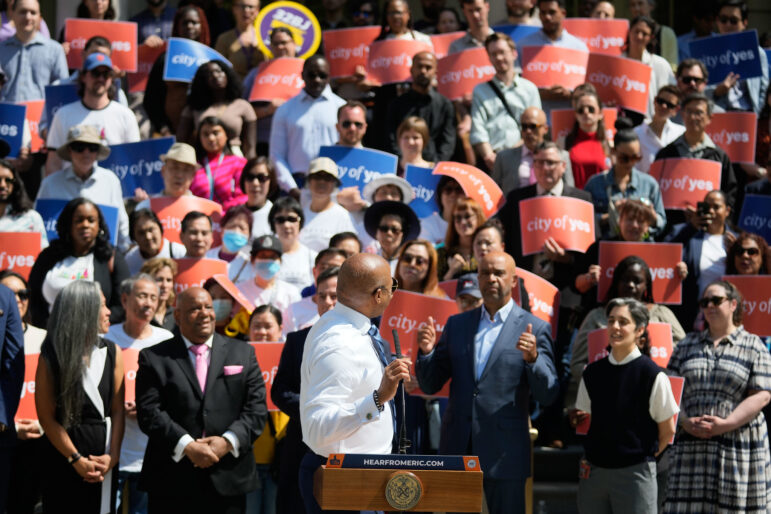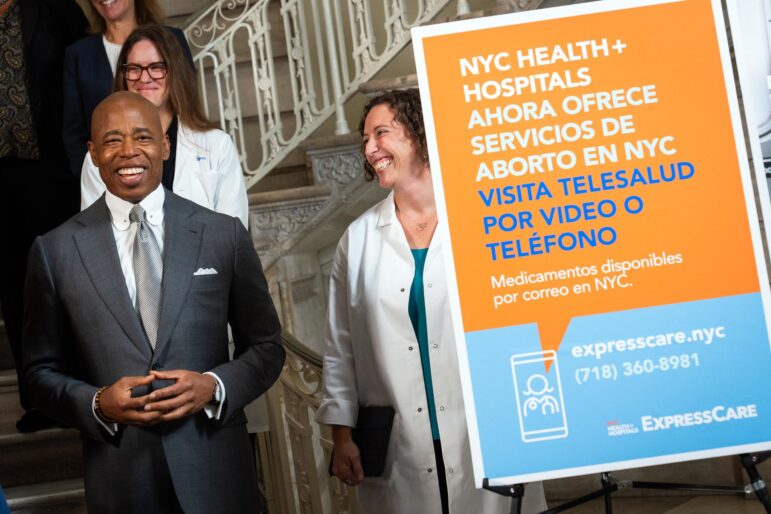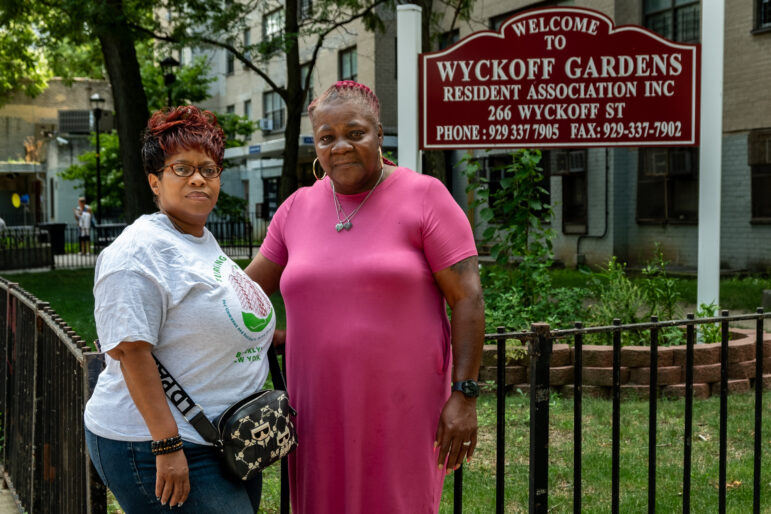
NYCHA
NYCHA's Olatoye (center, with yellow scarf) at a 2014 tour of the Queensbridge Houses. One bright spot for NYCHA -- a new plan to extend the hours during which tenants can get service visits -- has become embroiled in a dispute with a labor union.
NYCHA got a grilling on Monday after City Council learned the authority’s 2016 deficit would exceed earlier expectations, despite an unprecedented infusion of $670 million in city capital and operating funds since De Blasio took office. While last year NYCHA projected a roughly $25 million operating deficit in 2016, they now expect a $60 million shortfall.
“I am impatient with the pace of progress,” said Councilman Ritchie Torres, chair of the public housing committee. “What assurances can you give us that you’ll be able to close the deficit?”
At the heart of concerns lay the NextGeneration NYCHA plan: NYCHA has reduced the amount of revenue it expects to generate through the plan over the next five years. Last May, the authority said the plan’s strategies would generate about $1.09 billion in five years, but the authority recently revised that projection to about $1.01 billion.
NYCHA chair Shola Olatoye tried to explain some of the disconcerting figures.
She praised the “generous support of a mayor who recognizes the importance of NYCHA’s success,” and said the city’s support did help NYCHA make capital repairs and achieve an operating budget surplus of $61 million in 2015, allowing it to bulk up its reserves. Yet that $670 million only begins to chip away at NYCHA’s $17 billion capital repair deficit or its projected annual operating deficit of $2.5 billion over the next 10 years.
The authority faces a continued deficit crisis due to federal underfunding, including a $159 million shortfall in 2016, combined with rising utility, healthcare and pension costs. In addition, 5,000 units built by the city and the state no longer receive city or state funding, forcing the agency to spread its limited federal funding across a wider portfolio of units.
Olatoye said they’ve had to revise NextGeneraton revenue projects due to delays and new studies. For instance, the agency originally projected they would raise $27.5 million in 2016 from the development of the first five infill development projects. The authority has rescheduled the release of RFPs to provide more time for meaningful resident engagement, according to Olatoye, and the authority now expects to generate only $500,000 from development projects this year.
The authority has also discovered that some strategies in the plan, such as the leasing of ground floors, will not be as profitable as originally expected. NYCHA originally projected that ground floor leasing would bring in over $6 million a year; they now estimate between $3.6 and $4.2 million. And while they originally projected savings of $93.7 million in 2020 by shifting NYCHA employees to other agencies, they now expect to save only $67.9 million.
“That’s a dramatic revision downward,” Torres bemoaned. He also urged NYCHA to work more aggressively to convert the 5,000 unfunded city and state-built units to Section 8 housing, a step that by itself would eliminate NYCHA’s annual operating deficit. Olatoye said the agency is escalating efforts to convert these units. The authority moved 300 units to Section 8 housing last year and plans to convert another 500 this year, but some of the families are not eligible for Section 8.
Some of the more controversial aspects of the authority’s NextGeneration plan did not escape comment, with Councilmember Inez Barron demanding 100 percent affordable housing on infill development sites, and other Council members calling on NYCHA to improve its communication with residents on the Rental Assistance Demonstration program in the Rockaways and on the transfer of senior centers to non-NYCHA managers.
Moving beyond NextGen, the Council inquired about the Department of Justice’s investigation into lead levels in public housing. Olatoye said that no complaint had yet been submitted, and said studies show the risk of lead poisoning in NYCHA housing is “relatively small.” She said that of one million children tested by the Department of Health over a five year period, 6,800 had elevated levels of lead, including 202 children residing in NYCHA. An investigation found that only 18 of those 202 children had lead paint in their apartments. “Those issues were immediately abated and those homes are now lead-free,” she said, adding that studies showed no widespread problem in water lead levels.
NYCHA did not lose the opportunity to celebrate its new Flexible Operations (FlexOps) program, which aims to shorten repair times by staggering employee schedules so repairs can be made at nighttime and managers can be reached on weekends. The Teamsters Local 237, however, filed an improper-practice complaint last week alleging that the new policy violated their work contract. Olatoye insisted the contract gives NYCHA the right to “to assign special shifts,” and said NYCHA will address the union’s safety concerns about working nighttime shifts by ensuring employees have flashlights, call radios, and work in supervised teams.
“The section of the contract clearly says 8:00 am to 4:30 pm, Monday through Friday,” insisted Gregory Floyd, president of the Teamsters Local 237 at the meeting. He said he didn’t trust Olatoye to implement any of their safety promises.









2 thoughts on “NYCHA Sees New Efforts Offering Less Fiscal Salvation”
What does it mean to convert 5000 units of city and state built NYCHA units to Section 8? These are NYCHA properties, are they not? Why are those apartments a drain on NYCHA operations? Why are they not funding by NYC & NYS cash?
Most NYCHA buildings were federally funded. But around 20 buildings or so were city/state funded. The city and state withdrew their funding in the 90s, which meant that nycha had to stretch federal funding, which had already been cut, to cover those buildings as well. However, I was under the impression that these buildings had been “federalized” during the stimulus in obama’s first term. There was some obscure section of the stimulus law that allowed those buildings to begin qualifying for federal subsidies and nycha called it “federalization.” Nycha made a big to-do about federalization 6-7 years ago, so why those buildings are still not funded is a mystery to me.